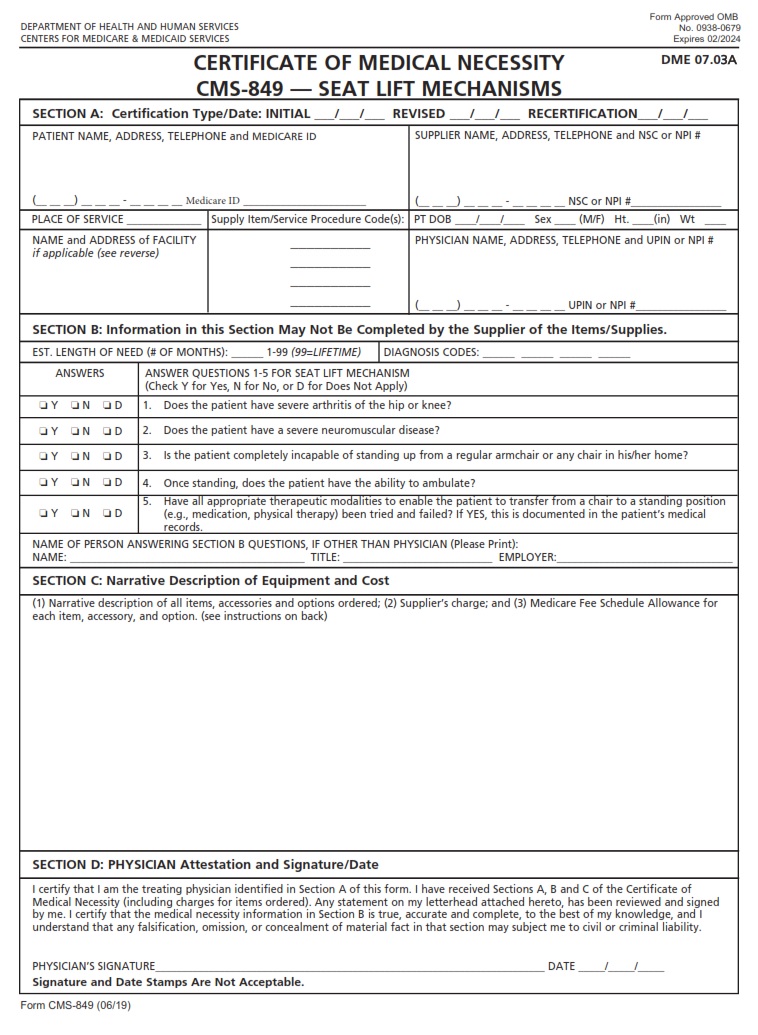CMSFORM.ORG – CMS 849 – Certificate of Medical Necessity – Seat Lift Mechanisms – DME 07.03A – In the intricate world of healthcare regulations and medical equipment, one document holds immense power – the CMS 849 Certificate of Medical Necessity for Seat Lift Mechanisms. This seemingly mundane form not only outlines the necessity of DME 07.03A devices but also serves as a gateway for patients seeking assistance in improving their quality of life. Imagine a world where a simple lift mechanism can transform everyday tasks into manageable feats, offering independence and comfort to those in need. As we delve into the complexities of CMS guidelines and explore the impact of seat lift mechanisms on patient care, we unravel a compelling narrative that highlights the intersection of technology, healthcare, and human resilience. Join us on this journey as we uncover the importance and significance of this essential document in shaping the lives of many individuals across the healthcare landscape.
Download CMS 849 – Certificate of Medical Necessity – Seat Lift Mechanisms – DME 07.03A
| Form Number | CMS 849 |
| Form Title | Certificate of Medical Necessity – Seat Lift Mechanisms – DME 07.03A |
| Published | 2017-02-01 |
| O.M.B. | 0938-0679 |
| File Size | 153 KB |
CMS 849 - Certificate of Medical Necessity - Seat Lift Mechanisms - DME 07.03A (1217 downloads )
What is a CMS 849?
A Certificate of Medical Necessity (CMS 849) serves as a crucial document in the Durable Medical Equipment (DME) world, specifically for seat lift mechanisms. It is not just a form to be filled out; rather, it represents the intersection of patient care and administrative processes. The CMS 849 ensures that patients receive the necessary equipment by detailing their medical condition and why a seat lift mechanism is essential for their well-being.
Through the CMS 849, healthcare providers articulate the medical necessity of seat lift mechanisms, often making a compelling case for insurance coverage or other forms of financial assistance. This certificate goes beyond mere paperwork; it symbolizes advocacy for patients’ quality of life and independence. By emphasizing the significance of the CMS 849 in facilitating access to vital equipment, we underscore how administrative procedures directly impact patient outcomes and overall healthcare effectiveness.
Where Can I Find a CMS 849?
If you’re on the hunt for a CMS 849 form for a seat lift mechanism, you’re in the right place. The best starting point is to check with your healthcare provider or supplier, as they should have access to this important document. However, if you prefer a more hands-on approach, you can visit the official Centers for Medicare & Medicaid Services (CMS) website where various forms, including the CMS 849, are available for download.
Another avenue to explore is contacting Durable Medical Equipment (DME) suppliers in your area who specialize in seat lift mechanisms. These suppliers are well-versed in the documentation required by Medicare and can assist you in obtaining the necessary paperwork. Remember that proper documentation such as the CMS 849 form is crucial when seeking reimbursement or coverage for medical equipment like seat lifts, so be sure to stay diligent in your search efforts.
CMS 849 – Certificate of Medical Necessity – Seat Lift Mechanisms – DME 07.03A
When it comes to navigating the complex world of healthcare reimbursement, understanding the nuances of CMS 849 – Certificate of Medical Necessity for Seat Lift Mechanisms under DME 07.03A is crucial. This certificate serves as a gateway for patients in need of seat lift mechanisms to receive coverage and access to essential medical equipment. Providers play a key role in accurately completing this form, ensuring that patients with mobility issues can enjoy a better quality of life.
Seat lift mechanisms are integral components of durable medical equipment (DME) that help individuals with mobility challenges maintain independence and functionality in their daily lives. The intricate process of obtaining a Certificate of Medical Necessity underscores the importance placed on proper documentation and compliance with regulatory guidelines. Ultimately, this certification serves as a testament to the commitment towards improving patient outcomes and enhancing access to vital healthcare resources.
